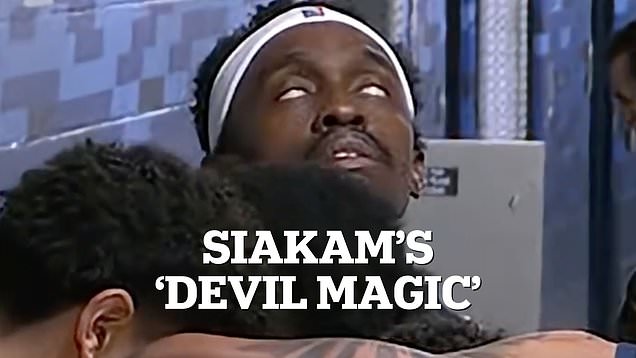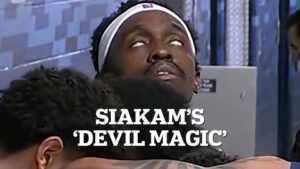
The Ritual That Shook the NBA
When cameras caught Pascal Siakam with his eyes rolled back and gestures too intense to miss before Game 6 of the 2025 NBA Finals, social media erupted. Fans went wild:
> “Pascal Siakam just turned into a demon.”
“Whatever demons he summoned pregame… they’re working OVERTIME.”
“Pascal Siakam really summoned the strength of his ancestors before the game.”
The resulting rumours ranged from supernatural possession to devil worship. Tweets and posts flooded with terms like “possessed,” “devil magic,” even “black magic”—especially after Indiana’s improbable comeback wins during the playoffs. Every clutch shot by Tyrese Haliburton or late-game rally seemed to fuel the conversation.
Which begs the question: What really was going on
Demons or Determination?
Contrary to wild speculation, Siakam’s ritual wasn’t an invocation of dark forces—it was pure intensity and mental preparation. In press interviews, he described it as entering a trance-like zone: “I never said I was possessed… I was just in a state where I could block everything else out and focus fully on the game.”
What he actually said:
The ritual helps sharpen focus, not summon demons.
He rolls his eyes back to enter a state of hyper-awareness.
Comparable to other athletes’ pregame routines, this behavior grounded him, not mystified him.
It’s a mindset that resonates with many elite competitors—blocking out distractions, entering “the zone,” and mentally locking in.
A Broader NBA Context: Superstitions & Rituals
Siakam is far from alone in using rituals before big games. Across the NBA, pregame routines run the gamut—from motivational to downright eccentric.
Legendary rituals:
Stephen Curry’s 60-foot hallway shot: He reps long shots pregame as a team-bonding ritual, calling it “mojo” generation.
Michael Jordan’s lucky shorts: Wore North Carolina practice shorts under his uniform for good luck—changing NBA fashion forever.
LeBron James’ chalk toss: Adapted from Kevin Garnett, it became a signature tip-off move.
Rasual Butler’s left-to-right routine: Putting on jersey and shoes left-first, taking exactly 5 sips of water before tip—small habits build mental anchor.
Even prankster chants and group dances before the game break tension and boost team energy.
Where “Devil Magic” Rumors Sprang From
With the Pacers pulling off multiple near-impossible comebacks this postseason (e.g., overcoming seven-point deficits in final minutes), fans began speculating about supernatural forces in their favor.
Add Siakam’s eye-rolling ritual into the mix, and social media narratives raced away:
Knicks fans allegedly hired a witch to cast spells against Indiana.
Defector put it satirically: “Are we several hundred words into this blog and yet to describe the game‑winning shot?… once the Pacers fall behind by 15 points, the game […] is being played according to rules that do not adhere to our physical laws.”
This all combined to form the image of a team playing with black magic. But these are pop-culture exaggerations, not evidence.
Siakam’s Own Explanation
In his statement after the Game 6 victory, Siakam acknowledged the spectacle but grounded it in reality:

> “It’s not voodoo or devil stuff. I’ve been seeing visions, hearing voices—game plans, plays, counters. Rolling my eyes helps clear the noise, slows my breathing, brings focus. That’s all.”
He spoke with calm intelligence, highlighting psychological strategies over supernatural theatrics.
Why Fans Got Carried Away
1. Visual impact: In-game atmosphere, dramatic eye-rolling — ripe for sensational interpretation.
2. Unbelievable wins: Clutch performances made people look for “explanations beyond basketball.”
3. Cultural trends: Modern audiences jump quickly to supernatural framing—witchcraft, curses, “devil magick.”
4. Social media amplification: A tweet gains traction, others echo, and memes form—a feedback loop.
Taken together, it was easy to mistake mental and physical preparedness for something more mystical.
The Real Takeaway: Mental Mastery, Not Magic
Far from actual witchcraft, Siakam’s ritual exemplifies how elite athletes prepare their minds:
Visualization: Blocking out external noise by triggering a meditative state.
Routine-building: Repeated gestures or mantras help condition focus.
Flow induction: These cues prime the brain for optimal performance under pressure.
This is standard practice among top performers in all fields—not just sports.
What the Coaches & Teammates Say
Though the ritual got attention, Pacers’ insiders brush it off as part of game-time professionalism:
Tyrese Haliburton emphasized team-wide emphasis on mental routine: “We all have methods—some pray, some meditate, some dance. Puros aim is clarity and connection.”
Coaching staff praised Siakam’s leadership, explaining the ritual’s precision—ignoring hype, focusing on execution.
So, Is It “Devil Magic”?
Absolutely not.
There is no evidence that Siakam is invoking demonic forces. Instead:
He is using a mental anchor to access peak performance.
He’s followed in the footsteps of Curry, Jordan, LeBron—who use non-traditional rituals to perform at their best.
The dramatic interpretations by fans are entertaining—but rooted more in culture than fact.
Athletes, Rituals & Performance Science
What makes these rituals fascinating isn’t mysticism—it’s simply sports psychology:
Routines transform nerves into calm through ritualized behavior.
Triggers like eye-rolling or chalk-tossing signal to the brain: *“Time to focus deeply.”*
These actions build mental muscle for stress handling, concentration, and entering the flow state.
Even trivial-seeming habits—eating specific meals, wearing “lucky” shorts—anchor focus and comfort under pressure.
Final Word: Myth vs. Mindset
Legend will say Siakam summoned a demon before Game 6. But the less sensational truth is far more powerful: the ritual is a tool of discipline and mental edge.
Whether it’s:
Curry’s mind‑bending range shots,
Jordan’s hidden shorts,
Butler’s water‑sip count,
Or Siakam’s pregame stare—
They’re all strategies for excellence, not invitations to the supernatural.
And in sport, that’s magic enough.
Siakam “devil possession” pregame ritual Intentional focus-inducing technique: eye-rolling, breathing, mindfulness
Fans invoked curses, spells, black magic Purely rhetorical—no real supernatural involved
NBA culture full of bizarre magick? Rituals common, but rooted in psychological routine and performance strategy
In the end, what fans dubbed “devil magic” was simply peak performance mindset. Siakam’s ritual reminds us that feats on the basketball court often begin not with chants, but with control of the mind. Not voodoo, just vision.
Leave a Reply